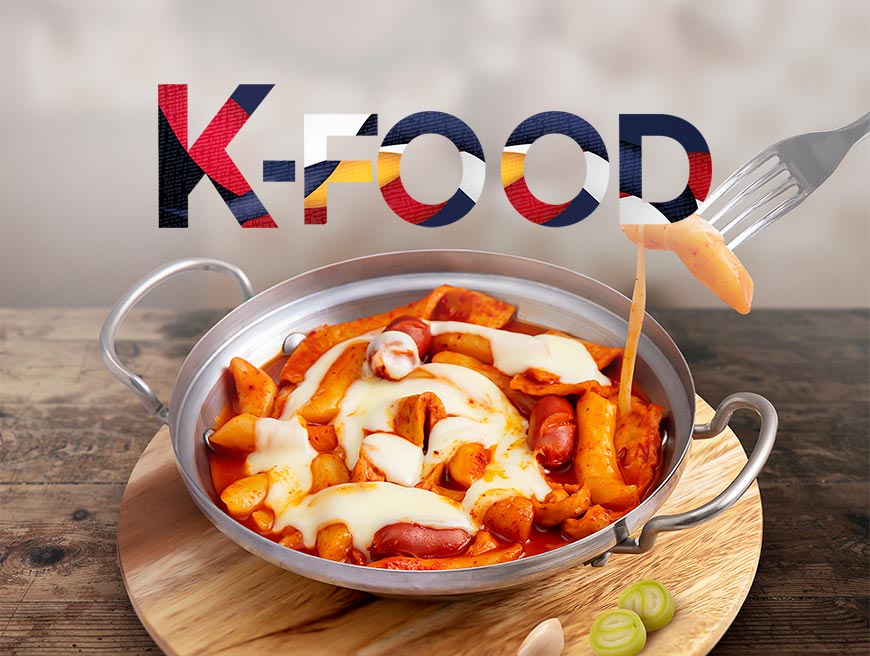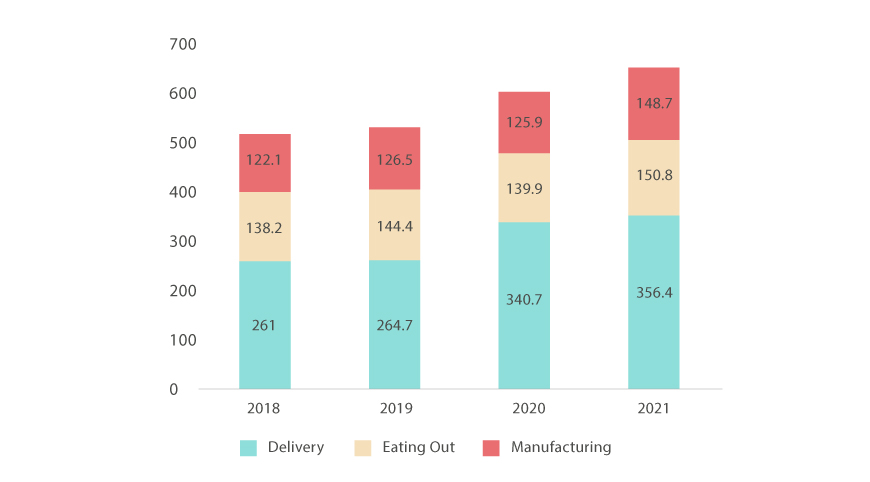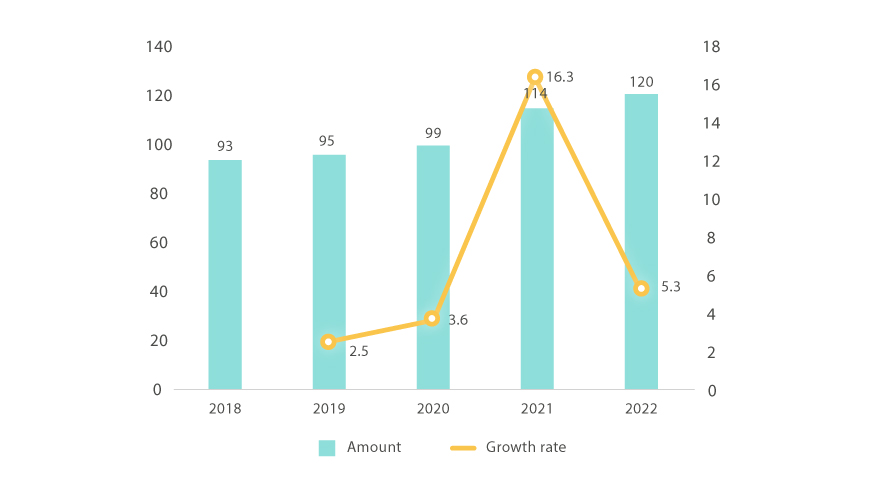Status of the Korean Food Industry
The food industry is emerging as a promising industry for the future based on the industry’s accelerated convergence with other fields such as high-tech, culture, and tourism and its growing added-value. The Korean food industry grew at an annual average of 8.0% from 2018 to 2021 to reach KRW 656 trillion in 2021, growing faster than other industries which grew at 7.4% during the same period. Based on the growth potential of the food industry, major developed countries around the world are striving to boost exports by fostering their food industries. The Korean food industry is also continuing its growth trend centered on K-Food, which has emerged as a hip food culture content around the world. In the 2023 Global Hallyu Trends Survey1, K-Food (49.1%) was found to be the most popular among the public, followed by Korean music and movies. Whereas K-Food has previously been limited to traditional foods such as bulgogi and kimchi, its popularity has spread to local foods such as ramyeon and tteokbokki. Based on the popularity, agricultural, fishery and food exports reached a record high of USD 12 billion in 2022, up 5.3% year-on-year despite difficult conditions involving inflation and disruptions in the supply chain. This can be seen as a result of the increased product value of K-Food that was combined with K-pop stars and food videos driven by the increased consumption of online cultural content. More specifically, the food industry insiders are very optimistic about the export outlook as the young generation around the world is leading the K-Food trend by leveraging social media..
Market size of the Korean food industry
(Unit: KRW trillion)
Exports of agricultural, fishery and food products
Outlook of the Korean Food Industry
Recently, the food industry is facing a rapidly changing environment—most notably changes in food consumption trends, the development of new technologies such as food tech, and threats to global food security triggered by climate change and the consequent disruptions in the supply chain of the global food market. In the face of these challenges, the Korean food industry, represented by K-Food, is unique in that it gains more power when combined with culture and produces convergent content. Globalization of the food industry will be accelerated if the industry is combined with cultural content, agriculture, fishery and food products and related service and approached from the perspective of creating convergent content. Moreover, K-food will be able to create added value rather than simply being consumed and establish itself as a cultural product leading the global market. What’s more, the rapid rise of food technology in recent years is expected to boost investment and development in this field, and various food services based on food technology are expected to be launched. At the same time, food consumption patterns are diversifying due to the increase in single-person households and the aging population, and new food markets such as convenience foods, medicinal foods, and functional foods are expected to grow. Changes in food consumption patterns are expected to create new markets, further accelerating the growth of the food industry. The domestic market is expected to face difficulties due to population decline in the long term, but food companies are expected to further expand their overseas expansion by seeking growth opportunities based on exports. The trend of K-Food is expected to be a sustainable growth driver rather than a fad, and in line with the rosy outlook, the food industry is expected to focus on product development and business expansion to lead future growth and new trends.
Government Policies to Foster the Food Industry
In recent years, the global food industry has continued to grow despite concerns over global recession. In order to boost the food industry, the Korean government has introduced policies to foster the food industry and support its globalization. At the same time, the government is lifting various regulations that stand in the way of the industry's revitalization. As Korea has already signed FTAs with major food markets such as the US and EU, as well as China and Vietnam, the government is actively implementing policies to foster and support the food industry for the globalization of K-Food. More specifically, new industries such as food tech and green bio are growing at a particularly fast pace, backed by the nation’s strength in information technology (IT) and biotechnology (BT). The government has set a policy direction to drive the innovation of the agricultural and food industries by promoting the exports of new industries such as food tech and green bio and upstream and downstream industries such as smart technology and agricultural equipment.
K-Food Export Strategy: Main Tasks
* Source: February 24, 2023 press release on the K-Content Export Strategy (4th Strategic Meeting for Promoting Exports), 2023. 2. 24
In addition, the government is establishing the Master Plan for the Promotion of the Food Industry every five years to strengthen the global competitiveness of the K-Food industry by considering its growing international reputation. The recently-announced 4th Master Plan set out a growth strategy for the food industry by reflecting the seismic changes in the food industry brought by COVID-19. The government plans to increase the size of the food industry from KRW 656 trillion in 2021 to KRW 1,100 trillion in 2027.
4th Master Plan for the Promotion of the Food Industry (2023-2027)
* Source: 4th Master Plan for Promotion of Food Industry (2023-2027), Ministry of Agriculture, Food and Rural Affairs, June 28, 202
By Han Jungmin ( (jmhan@kiet.re.kr))
Researcher, Economic Outlook and Analysis Division, Korea Institute for Industrial Economics & Trade














